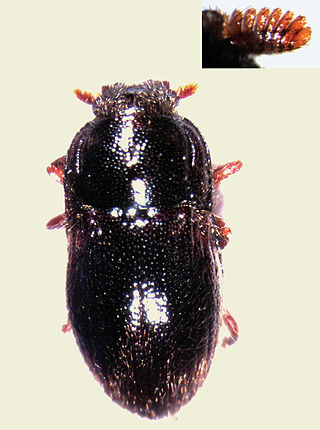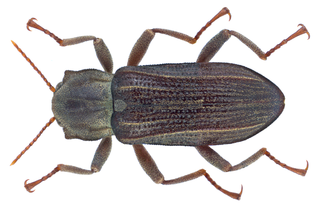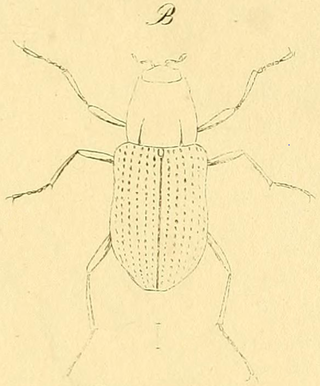
Papilio palinurus, the emerald swallowtail, emerald peacock, or green-banded peacock, is a butterfly of the genus Papilio of the family Papilionidae. It is native to Southeast Asia, but is regularly kept in butterfly houses around the world.

Byrrhoidea is a superfamily of beetles belonging to Elateriformia that includes several families which are either aquatic or associated with a semi-aquatic habitat. Other than the superfamily Hydrophiloidea, most of the remaining Polyphagan beetles which are aquatic are in this superfamily.

Silvanidae, "silvan flat bark beetles", is a family of beetles in the superfamily Cucujoidea, consisting of 68 described genera and about 500 described species. The family is represented on all continents except Antarctica, and is most diverse at both the generic and species levels in the Old World tropics.

Copelatus sociennus is a species of diving beetle. It is part of the subfamily Copelatinae in the family Dytiscidae. It was described by J. Balfour-Browne in 1952. The species can be found on Coloane and in Seac Pai Van. It feeds on Nelumbo nucifera.

Dryopidae is a family of beetles, commonly named long-toed water beetles, in the superfamily Byrrhoidea. It was described by Gustaf Johan Billberg in 1820.

Elminae is a subfamily of riffle beetles in the family Elmidae. There are at least 120 genera and more than 1,300 described species in Elminae.

Elmini is a tribe of riffle beetles in the family Elmidae. There are more than 90 genera and 1,200 described species in North America.

Dicranopselaphus is a genus of water-penny beetles in the family Psephenidae. There are over 40 described species in Dicranopselaphus, distributed in Asia and North America.

Phanocerus is a genus of riffle beetles in the family Elmidae. There are about seven described species in Phanocerus.

Zaitzevia is a genus of riffle beetles in the family Elmidae. There are about 19 described species in Zaitzevia. The genus is named after the Russian entomologist Filipp Zaitsev.

Grouvellinus leonardodicaprioi is a species of riffle beetle in the superfamily Byrrhoidea. The beetle was discovered by citizen scientists working with a group of scientists from Taxon Expeditions. G. leonardodicaprioi belongs to the family Elmidae, and it is endemic to Malaysia.

Grouvellinus is a genus of beetle in the family Elmidae. As of 2018, over forty species are recognized, including:
Grouvellinus duplaris is a beetle species from the riffle beetle family. The scientific name of the species was published in 1923 by Champion. It is endemic to India.

Epimetopidae is a family of semi-aquatic beetles belonging to the Hydrophiloidea. They are found in sand and gravel at the edges of streams, rivers and shallow freshwater ponds. These beetles are shorter than half a centimeter long and have a pronotum with a central projection forming a shelf above the head. On the underside of the abdomen only four sternites are visible. There are approximately 72 described species in three genera, Epimetopus which is restricted to the New World, mostly Neotropical, Eupotemus with two Afrotropical species and Eumetopus with some Oriental species. Females carry their eggcases on the underside of the abdomen. The larvae are probably carnivorous based on their mouthparts and likely live in the same habitats as the adults.

Prosopocoilus buddha is a species of stag beetle in the tribe Cladognathini. This Asian species is variable, with several known subspecies and widely distributed from India to Sulawesi.
Erymus gracilis is a species of rove beetle widely spread in Oriental region. It is found throughout China, Sri Lanka, India, Bhutan, Thailand, Malaysia, Laos, Indonesia, Myanmar, and Nepal.
Ancyronyx jaechi is a species of riffle beetle found in Sri Lanka.
Ilamelmis foveicollis, is a species of riffle beetle found in Sri Lanka.
Zaitzeviaria bicolor, is a species of riffle beetle found in Sri Lanka, Philippines and Vietnam.

















